What is Hereditary about?
Hereditary is a film that explores family trauma, grief, faith, and mental health. Its limited perspective allows for a tremendous surprise as we catch up on the depth of backstory that’s led to current events. A narrow film, Hereditary manages a sense of scope through its exploration of the afterlife and intimation that demons really and truly exist. Of note, is the film’s structure. The first half is mostly grounded in reality. After a tragedy, the later portion becomes more surreal then escalates to the supernatural.
While full of shocking and powerful moments, Hereditary is probably less subtextual than it seems. Much of what’s to discover is backstory and world building rather than a deeper metaphor or social commentary. With that said, Hereditary is a portrait of grief that’s quite striking as a dramatization of what happens when trauma tears a family apart. And is one of the most interesting horror films of the 2010s.
Cast
- Annie Graham – Toni Collette
- Steve Graham – Gabriel Byrne
- Peter Graham – Alex Wolff
- Charlie Graham – Milly Shapiro
- Ellen Taper Leigh – Kathleen Chalfant
- Joan – Ann Dowd
- Bridget – Mallory Bechtel
- Written by – Ari Aster
- Directed by – Ari Aster
The ending of Hereditary explained
Recap
Hereditary’s ending begins with Peter waking up in his bedroom in an all-too-quiet house. Unbeknownst to him, the body of his possessed mother hides in the upper corner of the room. In the living room, he finds the charred body of his father. Before he has time to process what’s happening, he sees a nude man in a doorway. Then “Annie” leaps at him. Peter flies back up stairs, trailed by demon Annie. Coincidentally, the attic ladder is there for him to climb up and hide. Gripped by terror, he devolves from calling his mom “mom” to calling her “mommy”.
In the attic, Peter discovers signs of the Paimon coven’s rituals. Lit candles. The spot on the floor where his grandmother’s corpse had been. A photo of Peter with his eyes poked out. He tries to wake himself up, convinced he’s dreaming. Suddenly, his mom’s floating close to the ceiling, sawing through her own neck. Ahead of Peter, more of the coven’s members, also nude. Peter jumps out the window.
Down the ground, a shadow drifts away from Peter’s body and out of the camera frame. Then a glimmer of light moves over the body, pauses, and diffuses into it. Peter awakens. He sees his mom’s headless body float into the treehouse. Peter clicks like Charlie. On the way to the tree house, he passes the family dog, also perished.
Inside the tree house, Peter finds the members of the Paimon cult. They’re nude and bowing. He turns to find an effigy. It’s Charlie’s decomposed head on a wooden mannequin with the Paimon symbol carved on the chest. The figure holds a staff and wears a crown. Next to it is a bird in a cage. In front of it, the body of Annie and Annie’s mother, Ellen. Both headless and positioned bowing. A portrait on the wall, of Ellen, has the title, “Queen Leigh”.
Joan rises from the ranks of the coven and takes the crown from the effigy. She puts it atop Peter’s head. Shockingly, the bodies of Annie and Ellen have rotated, turning from the effigy to Peter.
Joan: Oh, hey, hey, hey. It’s alright. Charlie. You’re alright now. You are Paimon, one of the eight kings of Hell. We have looked to the Northwest and called you in. We’ve corrected your first female body and give you now this healthy male host. We reject the Trinity and pray devoutly to you, great Paimon. Give us your knowledge of all secret things. Bring us honor, wealth, and good familiars. Bind all men to our will, as we have bound ourselves for now and ever to yours. Hail, Paimon.
The last shot is zoomed out and shows the scene from the tree house except it’s a wooden miniature of the scene. A miniature just like the kind Annie made.
Meaning
Diegetically speaking, in Hereditary, demons exist. Spirits exist. Spiritual possession is possible. What happens in the end is the conclusion of a decades-long plan enacted by this coven to bring the demon king Paimon into this world. Why? It’s said that the “Conjurer” is to receive riches. A drawing in a book displays a person sitting atop a mountain of gold and jewels. But it’s also said that through Paimon, people will gain knowledge, wealth, and the ability to influence the will of others. Which is what Joan requests at the crowning ceremony.
It’s said in the same book that Paimon dislikes being in a female host and gets angry about it. So what seems to have happened is “Queen Leigh”, Annie’s mother, initially conjured Paimon into Charlie. But Paimon was upset with them and wouldn’t bestow his favor upon the coven. Which meant they had to perform a whole ceremony to unbind Paimon from Charlie and re-bind him to Peter. It seems the preparation for this took a number of years but the movie picks up with the beginning of the unbinding ceremony. Over the course of the film, we witness both the unbinding and rebinding ceremonies. The first concludes with Charlie’s death. The second with Peter’s possession.
That means almost everything that happens to Charlie, Annie, and Peter is by design. For example, the coven had already branded the telephone pole that takes Charlie’s head off. That implies they knew what would happen there before it happened. We can also assume they put the deer corpse in the road that caused Peter to swerve close to the pole. Likewise, the only reason Annie reads an incantation that allows Paimon’s spirit into her home is because Joan, a member of the coven, manipulates her. This idea of characters caught in a design is reinforced by Peter’s high school English class and the discussion on the story of Heracles and if Heracles is to blame for events if those events are preordained. Is it more tragic or less tragic if someone doesn’t have a choice in what happens?.
It’s unclear if it’s the spirit of Paimon in Annie during the final stretch or some other evil spirit who is assisting in events. Either way, the goal is to bring about Peter’s death. The coven members seemed positioned in a way to either drive him toward the attic or because they already knew the attic would be the climactic site (just like they knew the telephone pole would be it for Charlie). After Peter falls, the shadow leaving his body is probably his spirit. While the light is Paimon.
The light is something shown throughout the film. The first time is at the 24:00 minute mark. Charlie’s at her desk, building something, when suddenly the light passes across the room. Then passes back and on the wall. Charlie goes to her window and looks out the window. The next time we see her, she’s outside, with the head of the bird, walking, as if possessed, toward the woods, following someone else’s footsteps in the mud. Out in the woods, she sees her grandmother’s body in front of a fire. Her encounter with the telephone pole soon follows. The next time we see it is near the end, at the 1:20:28 mark. Peter then sees his reflection and his reflection is smirking, as if it was someone else, not him.
It seems safe to say then that the light is probably Paimon’s spirit. He has some connection to Charlie. Then a similar influence over Peter. But it’s not until Peter technically “leaves his body” that Paimon can fully take over. This idea that Paimon is present in spirit form probably adds to the cinematography throughout the film and the use of miniatures. As in, spirits may be looking at the world as if the world were a miniature. And there are times that the camera’s floating around as if from the perspective of a spirit in the house. Whether Paimon’s, Ellen’s, Charlie’s, whoever.
The main question seems to be not what happened but what happens next. If Paimon is the God of Mischief. One of eight demon kings of Hell. What’s that mean for the Earth? How much power does Paimon possess while in the body of a high school kid? Through his influence, wll the coven become incredibly rich and powerful? What does that look like? Are they reshaping global politics? Or getting the local mayor to repave the roads? Are they all billionaires? Or do they have a timeshare in Florida?
And what does Paimon do? He probably isn’t going to just go about Peter’s life? It would be silly if he graduated from high school, went to college, got a job, worked his way up the corporate ladder, and got married. Etc. Etc. So what does he do? Bring about Hell on Earth? Just hang out with the coven all day? From what we see, there’s not much personality. But that might just be the shock of the transference ceremony.
Lastly, when Joan mentions looking to the Northwest, it’s probably that each of the eight demon kings identifies with a coordinate. N, NE, E, SE, S, SW, W, NW. Paimon is to the Northwest what another might be to the Southeast. Also, the mention of rejecting the Trinity does imply that Christianity is real in the same way the demons are real. Though we don’t really see any evidence of a more divine presence.
The themes and meaning of Hereditary
Powerlessness and fate in regard to mental health
One of the film’s earliest scenes has Peter in a high school English class. What’s discussed by the teacher actually frames the events of the movie (something also done in Donnie Darko).
- Teacher: So, if we go by the rule, that the hero is undone by his fatal flaw, what is Heracles’s flaw?
- Bridget: Arrogance
- T: Okay. Why?
- B: Because he literally refuses to look at all the signs that are being literally handed to him the entire play.
- T: Okay. Interesting. So he thinks he has control. But let’s all remember, Sophocles wrote the oracle so that it was unconditional—meaning Heracles never had any choice, right? So does that make it more tragic or less tragic than if he has a choice?
- Random Student: Less.
- T: Okay. Why?
- RS: Because.
- T: Care to weigh in, Peter?
- Peter: Um, about which part?
- Random Student 2: I think it’s more tragic, because if it’s all just inevitable, then that just means that the characters had no hope. They never had hope because they’re all just, like, hopeless. They’re all, like, pawns in this horrible, hopeless machine.
On the chalkboard behind the teacher, we see the heading THEMES followed by bullet points like “Escaping fate” and “Relationship between knowledge + responsibility”.
Obviously, in the events of the film, the thing Peter can’t escape from is the Paimon coven’s machinations to move Paimon’s soul from Charlie to Peter. There’s a marking on the exact telephone pole Charlie hits her head on, as if pre-ordaining what would happen. It seems safe to assume the coven even puts the deer in the road that causes Peter to swerve near the pole. It seems Peter, Charlie, and Annie are the pawns in this horrible, hopeless plot that’s stripped them of all power.
But the conversation transcends those events. Horror films are often metaphors for real life issues. Whether the original Frankenstein novel from 1818 and its meditation on the boundaries and responsibilities of science. Or something as recent as It Follows and its defamiliarization of anxiety or Lights Out and its monster as a representation for bipolar disorder.
Hereditary makes a point of specifying Annie’s family’s history of mental disorder. Someone might argue this is a red herring, that introducing family mental disorders creates doubt within the viewer as to what we’re watching. Are supernatural forces really at play? Or is Annie having a mental episode brought on by tragedy? For example, Annie mentions her brother had schizophrenia and blamed their mother for putting personalities inside of him. It turns out, in the world of Hereditary, you really can put personalities inside of someone. So was Annie’s brother actually schizophrenic or was what happened to him just misunderstood?
The answer is probably a bit of both. Thematically, it seems Hereditary is, like Frankenstein, It Follows, and Lights Out, defamiliarizing a topic via the realistic presentation of something fantastic. In this case, it’s mental illness dramatized via the soul transference of a demon king named Paimon. Dismissing the mental health talking points as red herrings feels simplistic.
With that in mind, it gives completely different context to the idea of the discussion around Heracles and the machine. Someone who has an inherited mental disorder never had a say in the matter. It’s a fate that will, at some point, sway a person’s behavior and life. It can be in minor ways, like having a bad day. Or in major ways, like ruining relationships or losing a career. Or worse. How do you escape that? Is it even possible? And what’s the relationship between knowing you have an issue and the responsibility that comes with having it?
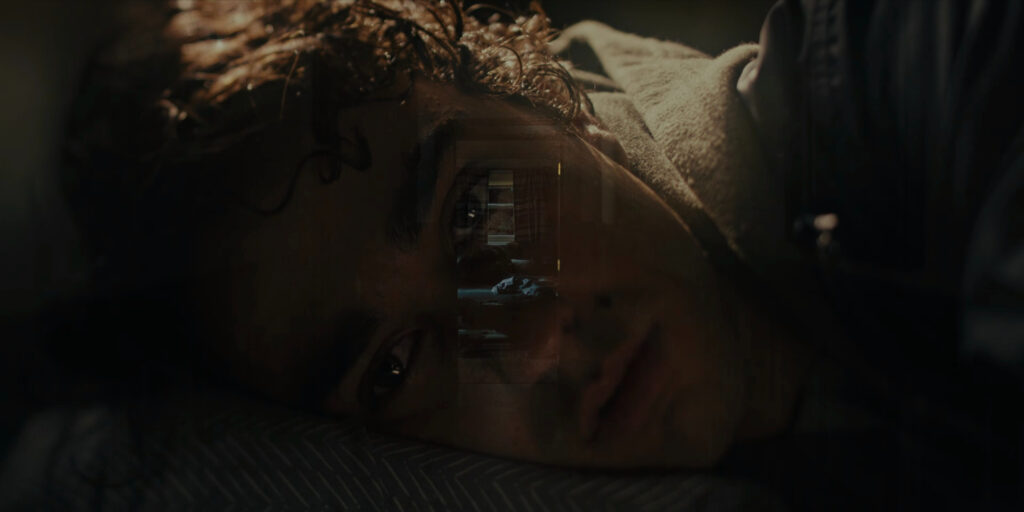
Family trauma
Annie is someone who has dealt with a lot of trauma in her life. And it affects her interactions with her own family. The complicated relationship with her mother has led to complicated relationships with her children. Her struggle to process her feelings leads to a strain in her marriage. Eventually, the death of her daughter causes a terrific break that brings a pall over the entire home. Her actions have a direct and profound impact on her husband and son.
This ties back to the Heracles discussion. Is Annie a victim of forces beyond her control? For example, it’s Joan who tricks Annie into reading the incantation that allows Paimon’s spirit to invade the house. It’s the coven/cult that sets Peter up to have the accident with Charlie. But did they have anything to do with Peter suggesting Charlie eat an unknown cake when he’s aware of her severe peanut allergy? But Charlie knew about her allergy. What’s her level of responsibility? Why didn’t Annie make sure they left with an EpiPen?
No one in Hereditary is innocent. But they all struggle to deal with the trauma. And no one makes it easier on anyone else. The shared trauma becomes too much and the family collapses in on itself.
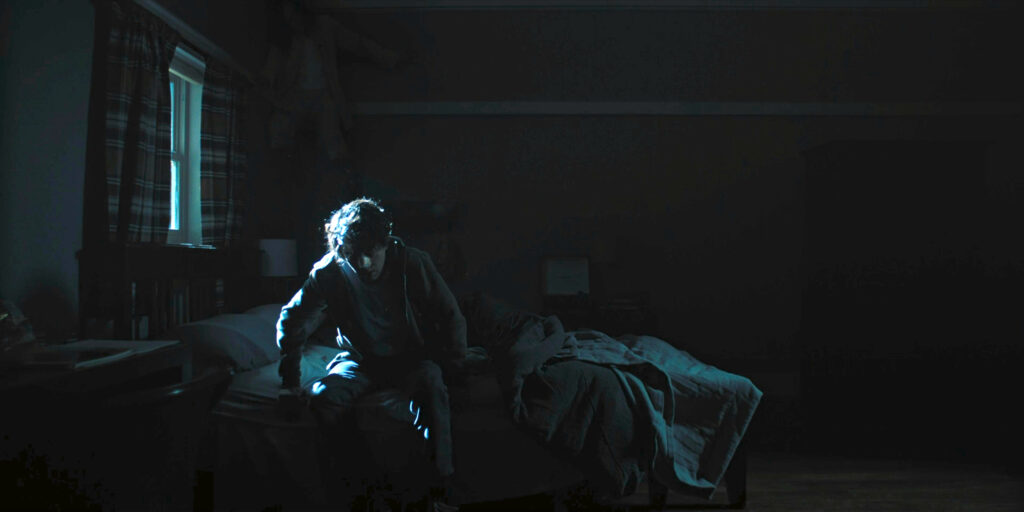
Faith
The Paimon coven has such faith in what they’re doing that they cause a lot of grief, pain, and loss of life to bring about Paimon’s transference into Peter. And it seems their faith is rewarded. The spiritual possession is real. It works.
That reality does bring up a number of questions. First, what reward does Ellen receive for helping to summon Paimon? Is there some kind of afterlife benefit? But there’s also a corollary. If Paimon exists, and he is one of eight demon kings in Hell, that seems to confirm not only the existence of demons, not only Hell, but the afterlife as a whole. So are there forces antithetical to the demon? Are there angels? Is there a heaven? Does God exist? If so, what does the reality of that brand of faith look like in this world? If any of the Graham family had expressed a belief in God or some other divine force, could they have been saved?
Why is the movie called Hereditary?
Single word titles like this almost always demand a dictionary definition. Merriam-Webster gives us four meanings.
-
- Biology: A: genetically transmitted or transmittable from parent to offspring. B: characteristic of or fostered by one’s predecessors
- A: a received or passing by inheritance of required to pass by inheritance of by reason of birth. B: having title or possessions through inheritance or by reason of birth
- of a kind established by tradition
- of or relating to inheritance or heredity
In case you’re curious about the difference between hereditary and heredity, heredity is “the sum of the characteristics and potentialities genetically derived from one’s ancestors” or “the transmission of such qualities from ancestor to descendant through the genes”.
In context of the movie, the title has several applications, one grounded, one less so.
The grounded explanation
When Annie goes to group therapy, she details her family mental health history. “[Her mother] had DID, which became extreme at the end. And dementia. And my father died when I was a baby. From starvation. Because he had psychotic depression and he starved himself, which I’m sure was just as pleasant as it sounds. And then there’s my brother. My older brother had schizophrenia and when he was 16 he h*nged himself in my mother’s bedroom and of course the s**cide note blamed her, accusing her of putting people inside him.”
Mental disorders are often hereditary. Or the conditions that give rise to them are hereditary. For instance, Dissociative Identity Disorder is not officially hereditary but certain genes may allow it to trigger more easily in one person than another. Depression is another example. Anyone can suffer from situational depression in the aftermath of a traumatic event or being stuck in a bad situation. Situational depression is often short-term. Whereas clinical depression is genetic and isn’t necessarily situationally triggered and can be far more invasive, pervasive, and devastating.
In Hereditary, we have a character in Annie whose mother and father both had severe mental disorders that sabotaged their lives. And a brother who seemed to inherit those difficulties. It would follow then that Annie probably also has some kind of struggle with mental health. And that her kids would as well. That’s what plays out in the film. After Charlie’s accident, Annie completely falls apart. And that eventually leads to Peter suffering from a similar “psychosis”.
You can read Hereditary as metaphoric for the way in which an episode of an untreated mental disorder, activated by extreme tragedy, can tear a family apart.
The in-world explanation
In the world of the movie, we have to accept things as they are presented. And in this world, the afterlife is real. Spirits are real. Demons are real. And it seems the cult of Paimon actually succeeds in transferring the soul of a demon king into Peter’s body.
This wasn’t the first attempt, though. As Annie noted, her brother accused her mother of “putting people inside him.” Which means Ellen had probably attempted the Paimon transfer with her son. It seems before it could work, he ended things. Whether Annie believed him or not, she rightly kept Ellen away from Peter, protecting Peter from becoming Paimon’s vessel. But then caved with Charlie. So the soul of Paimon went from Ellen’s son to Ellen’s granddaughter to, by the end of the movie, Ellen’s grandson. Making Paimon’s soul this inherited thing.
What happens next is anyone’s guess. I can’t imagine Paimon will just lead a normal life? But it’s likely that via his cult he’ll procreate and continue to transfer his soul from heir to heir. Which gives a more forward-looking view of the title.
Important motifs in Hereditary
Miniatures
Annie is a renowned miniature artist, creating tiny, extremely detailed renderings of places and scenes. Hereditary uses the camera in such a way as to sometimes make the real world appear as if it were a miniature. The first example of this is the opening scene. The camera goes from looking at the treehouse out a window to a miniature of the Graham house. It zooms in on the replication of Peter’s room, allowing the room to fill the entire frame. Without a cut or transition, the miniature becomes reality. It’s actually Peter in his bed. His father, Steve, and the family dog enter the room. On the flip side, the very end of the movie cuts from being in “reality” to being a miniature of Paimon’s crowning in the treehouse.
The importance and meaning of the miniature isn’t something Hereditary ever has explicit dialogue about. We see Annie create miniatures based on her life. These range from something neutral, like the Graham house, to the traumatic, like the scene of Charlie’s accident with the telephone pole, complete with head in the road.
A potential consideration comes into play when you consider the camerawork in Hereditary. For instance, in the opening scene, the camera roves as if in a first-person perspective. It’s a bit too rigid to feel completely natural, like someone turning their head or walking forward, but, all the same, there’s something present about it. This idea of presence lines up with the fact that throughout Hereditary spirits are in the house. The afterlife is real. It’s not just a trick of the eye that Annie sees the ghost of her mother, Ellen. Ellen’s spirit is there. And at points throughout the film, Aster makes sure to use an actual POV shot. Whether it’s a teacher walking up on Charlie not paying attention in class, or Peter checking out his classmate. The use of POV shots at other points reinforces the notion that sometimes there are POV shots from the spiritual perspective.
The implication of this would be some commentary on the scale and scope of the world. In Hereditary, the afterlife exists. Hell exists. Heaven probably exists. Meaning our reality is just a small part of the whole. There are much larger forces beyond our comprehension. They would probably look at our world as this miniature they’re observing. So that opening shot where the “camera” moves into Peter’s room could be read as, say, Ellen’s spirit or Paimon’s spirit moving into the house.
There’s also something to the idea of the miniatures being similar to dolls and doll houses. Which would tie into the idea of the theme of powerlessness and fate. Powers beyond our comprehension are maneuvering and manipulating individuals. Charlie, Peter, Annie, Steve. None of them really had a choice or chance. The same way Annie is a “god” of the miniatures she creates, there are Annie equivalents “making” the “miniature” that is our reality. Which would explain the very final shot of the movie.
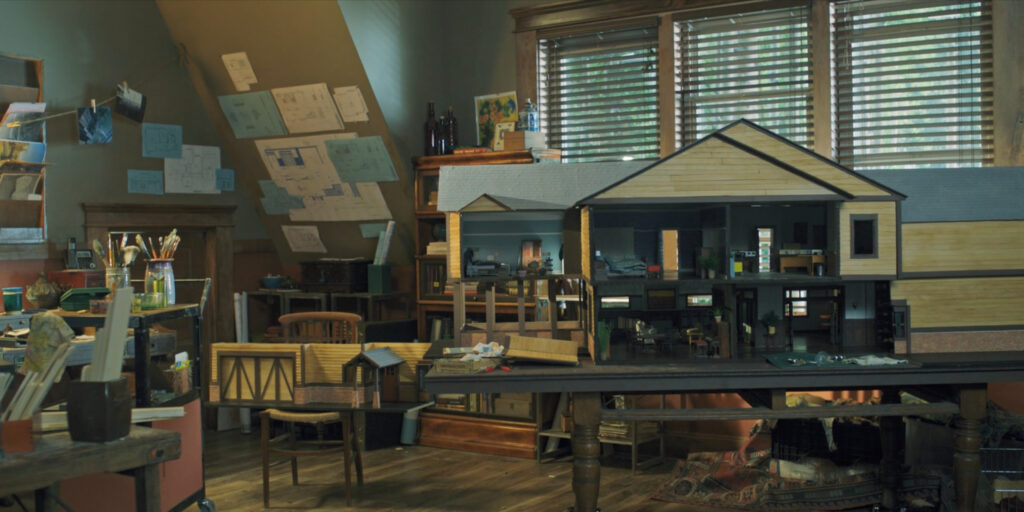


Missing heads
Charlie cuts off the bird’s head. She loses her head. The coven removes Ellen’s head. Then a possessed Annie saws off her own. This is all part of the ceremony to move Paimon’s spirit into Peter’s body.
Generally speaking, human bodies are interchangeable. Identity is associated with someone’s head. Their face. Their brain. If your friend kept the same head but had a new body, it would probably be shocking but familiar enough. If they had the same body but a completely different head—a whole new face—they’d probably feel completely alien.
It seems the implication in Hereditary is that headlessness is important to possession, to the swapping of one identity for another. One of Ellen’s books does note that a ceremony must be performed to unbind Paimon’s spirit from one body to move it to another. Maybe there’s something to the idea of noggin-chopping as a means of freeing a body from possession? Either way, the broader concept that’s important to the conversation is identity.
And mental health? On a more practical level, Hereditary deals with the genetic aspect of mental disorder. How a disorder can pass from parent to child and the impact untreated disorder can have on a family. The emphasis on missing heads could be symbolism tied to this concept.
The Treehouse
It seems Ellen’s coven knew for a while that the treehouse would be the location for the crowning of Paimon. Hereditary implies everything that happens is pretty much fated and out of the control of Charlie, Peter, Annie, and Steve. Meaning that the opening shot of the treehouse is a pointed one. It’s the film essentially acknowledging, “See that place? We’re going to end up there in just a bit.” If Paimon’s possession of Peter is as big of a deal as Ellen’s book on the topic makes it seem—he is a demon king, after all—then the treehouse is essentially the place where the world changes forever.
So all the imagery of the treehouse, especially with the red light shining from it, foreshadows the demonic ceremony that will take place there.
The gleaming light
A light appears at several points in the movie. It’s never in quite the same shape. Sometimes it just dances on a wall. One time it’s a rectangle that passes through the school hallway and over Peter. At the end, it moves along the ground then into Peter’s body.
Given what we know about the plot to put Paimon in Peter and the fact that spirits are real and in the house throughout the movie, the gleaming light seems to by a byproduct of spiritual presence. Often it’s probably specifically Paimon. After it passes over Peter in the hallway, we have the scene in the classroom where Peter sees another him reflected in the glass of a cabinet. Then Paimon exerts some control by making Peter smash his face into his desk.
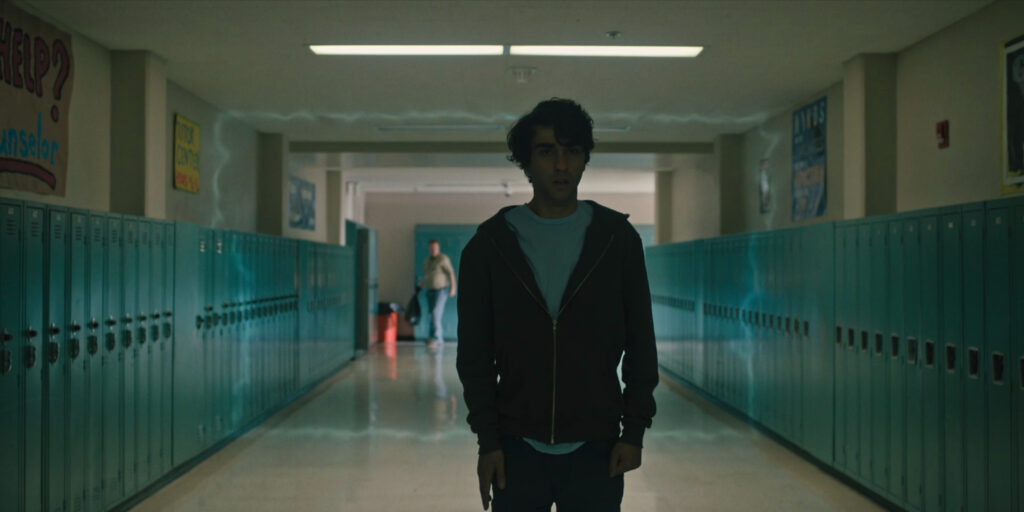
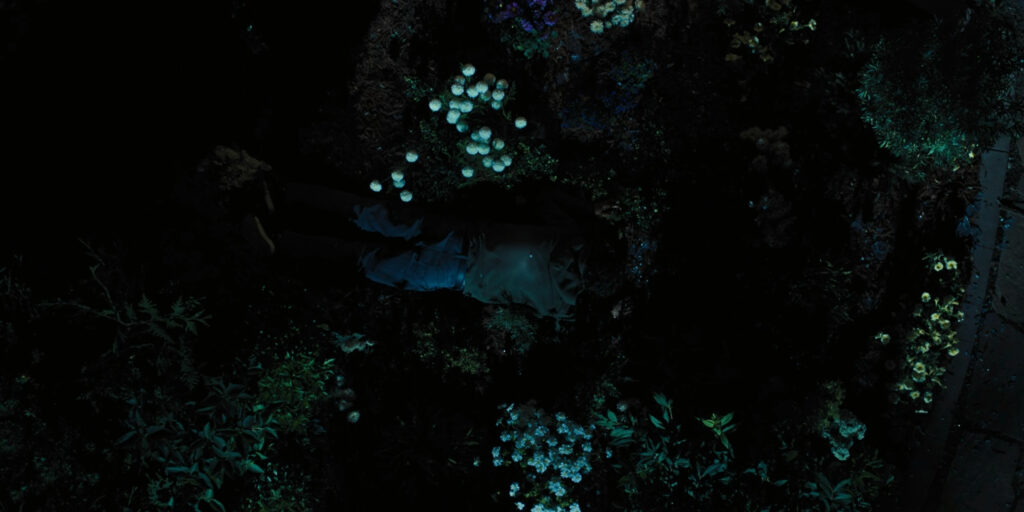
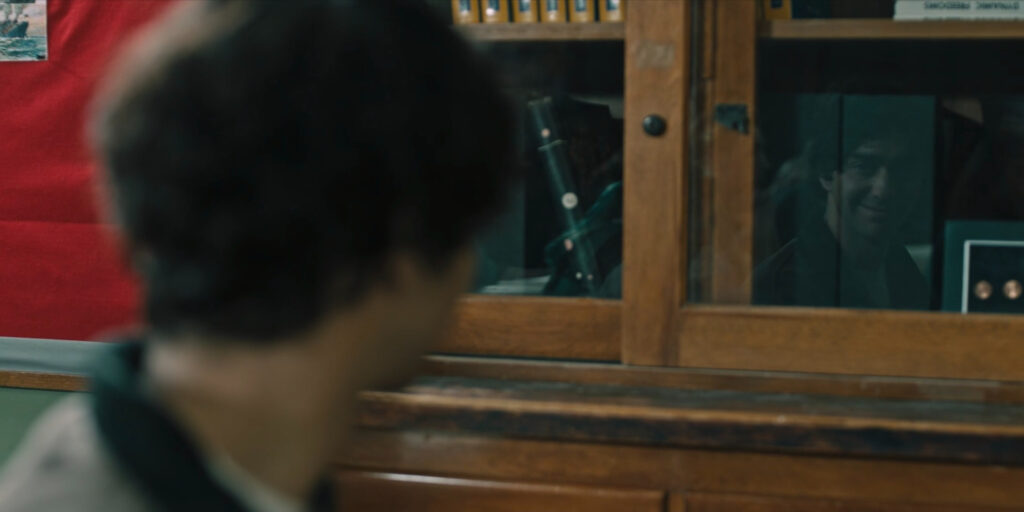
The mark of the coven
The mark of the coven appears throughout the film. Sometimes it’s just a sign that someone is a member, like the neckless that Ellen wore. Other times, it’s part of their ritual to get Paimon into Peter’s body. For example, we see it on the telephone pole that decapitates Charlie. The implication being the coven had cast some kind of spell to tip events so that Charlie’s head connected with that pole.
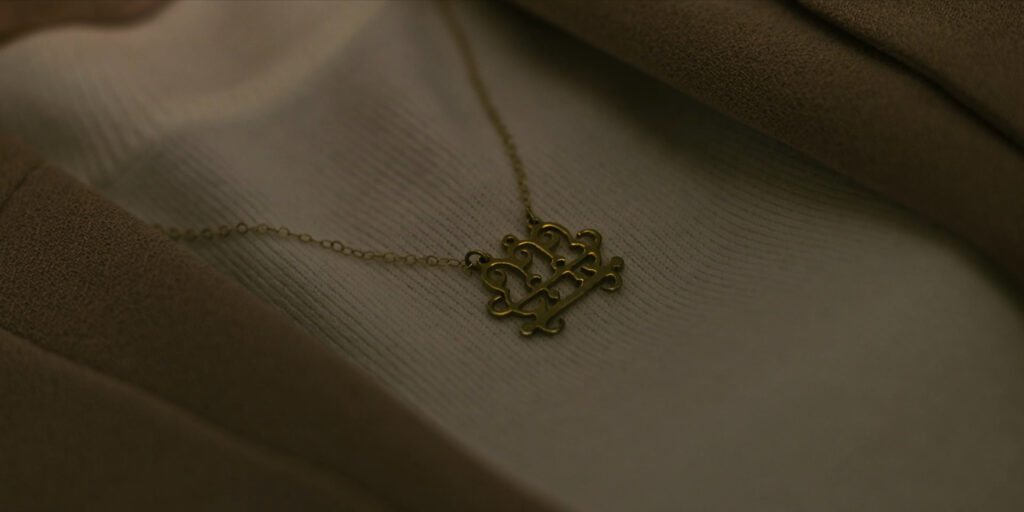
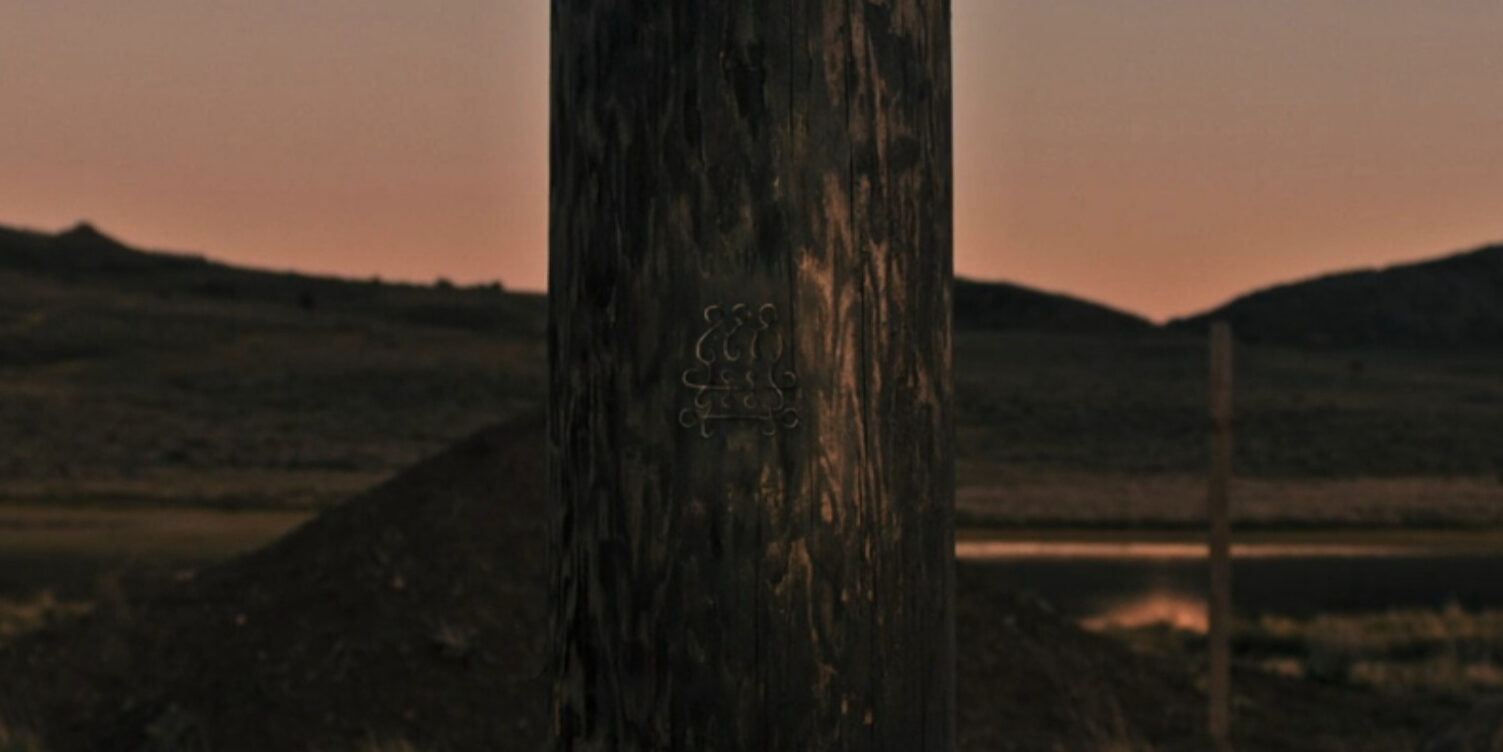
Questions & answers about Hereditary
What is Hereditary about?
Hereditary is about the impact of family history. Parent to child. Ari Aster explores the topic in both grounded and fantastic ways. The fantastic expression is Annie’s mother’s cult’s efforts to put the soul of the demon king Paimon into the body of a boy related to Annie’s mother. First it was Annie’s brother. Then Annie’s daughter. Now it’s Annie’s son. The grounded interpretation of this is the much more relatable idea of genetic mental disorders. We get a hint of this when Annie’s in group therapy and explains her mother had Dissociative Identity Disorder, her father had Psychotic Depression, and her brother had Schizophrenia. It’s likely she’s also dealing with an untreated illness.
You can read more about our explanation of the title (here) and themes (here).
What happened to Charlie?
Background
There’s a miniature we see of a scene with Annie, in bed, holding a newborn, and Annie’s mother, Ellen, is next to the bed, offering a tit for breastfeeding. We also learn that Annie actively kept Ellen away from Peter when Peter was born. Then, feeling guilty, let Ellen be present for Charlie. Annie explains that Ellen immediately had her hooks in Charlie. The implication is that Ellen, very early on, found a way to bind Paimon’s spirit to Charlie. Which is why Charlie is so strange.
It’s unclear if Charlie is always Paimon or if Paimon comes and goes or if Charlie is more of an anchor point and is often just her own, individual self. It’s interesting that when Peter first comes under Paimon’s possession, while in the middle of class, there’s a distinct change to his face. The contortion isn’t identical to Charlie’s features but there’s a degree of similarity that may be intentional.
Joan also refers to the Paimon-possessed Peter at the end of the movie as Charlie. Which does lend to the idea that Charlie was always Paimon-y. Though the implication of that is pretty hilarious. It would mean one of the eight demon kings of Hell just goes to school and does arts and crafts and eats cake at high school parties.
Even if the specifics are hard to pin down, what we do know is that Ellen actively cultivated Charlie as a resource for the coven’s goals. It’s why Charlie’s so strange.
The night of the accident
The night of the accident is brought about because Charlie is allergic to peanuts. We first find this out at Ellen’s funeral when Charlie’s eating a candy bar. Her dad asks her if there’s nuts and she says no. Annie makes reference to not bringing an EpiPen. This establishes both the allergy and the lax way the family thinks of the allergy.
Prior to the accident, Peter brings Charlie with him to a party because he lied to his mom and said it was a school event. The party is fun for Peter, awful for Charlie. In order to distract her, Peter points out a chocolate cake. It’s an irresponsible move. Peter knows his sister’s allergic but risks her life. Charlie also knows better but eats the cake anyway. Sure enough: peanuts. It seems no one at the party had an EpiPen. Instead of waiting for an ambulance, Peter decides to drive Charlie to the hospital himself.
This is where things take a turn. On the way to the party, there’s a shot of a telephone pole. And on the pole is the mark of Ellen’s Paimon coven. One of the main themes of Hereditary is the idea of the characters being stuck in events that are preordained. Meaning they’re powerless to do anything to prevent them. The mark on the telephone pole implies that the coven willed this accident to happen. So were Peter and Charlie actually irresponsible? Or caught up in something out of their control? Peter swerves the car toward the pole because there’s a dead deer in the road. It’s likely the coven put the deer there.
The main question is whether or not Charlie purposefully or unwittingly had her head out the window. She’s clearly in pain. But she’s also the vessel of the demon king Paimon. Who wants out of her body and into Peter’s. The loss of the head is part of that unbinding process. Regardless of the specifics, Charlie was influenced to put her head out the window. Just like Peter was influenced to steer near the pole. This was all part of the coven’s plan.
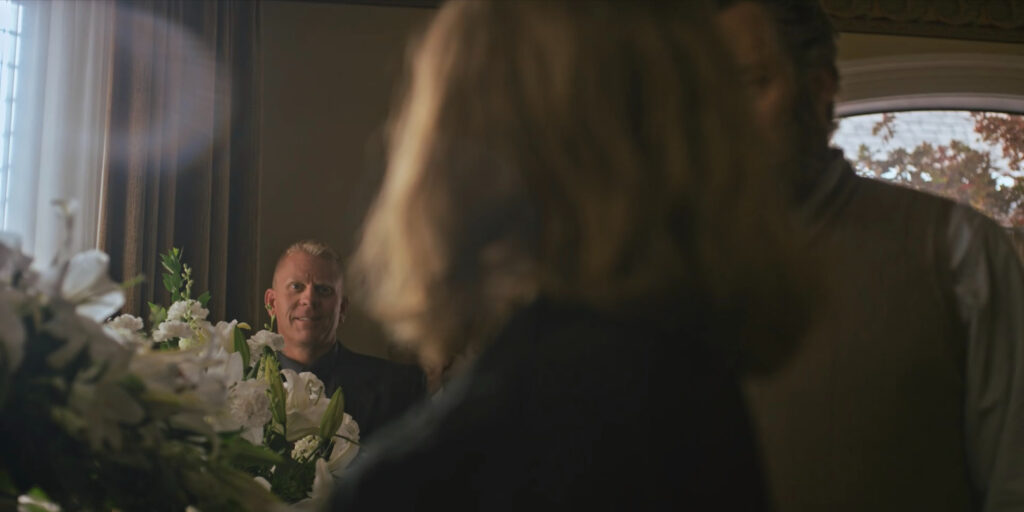
What happened to Peter?
We see in Ellen’s Paimon book that Paimon can be in either a male or female body but prefers a male body. To the point where he’ll get upset if he’s not in a male host. Unfortunately for the coven and Paimon, they didn’t initially have access to Peter. Meaning, for whatever reason, Ellen bound Paimon to Charlie. All of the events in Hereditary are part of the coven’s machinations to unbind Paimon from Charlie and rebind him to Peter.
The first part of that is Ellen’s death. Then Charlie’s. Then it’s using Annie to unwittingly perform some spells that create a portal to the spirit world. Then it’s weakening Peter in order to expel him, mind and soul, from his own body. Once that’s done, Paimon walks right into Peter’s body.
So at the very end, the cult has successfully installed one of the eight demon kings of Hell into Peter’s body. What does this mean? We have no idea. The consequences of this aren’t even hinted at. Does Paimon keep living Peter’s life as normal? Does he take over the world? Does he use the coven to bring for the other demon kings? Does he just play video games all day?
The more grounded explanation is that Annie’s family has a long history of mental illness. What we see in the movie is symbolic of Annie’s psychotic episode. Peter’s the only survivor. Not only is he severely traumatized, he’s also genetically likely to have similar mental health struggles for the rest of his life. Issues that will probably be forever exacerbated by what he’s just experienced.
Why did Annie cut her own head off?
Joan tricks Annie into casting a spell that connects Annie to the spirit world. Essentially making her ripe for possession. We see the initial possession that scares Peter and Steve. The next and final one happens right after she tries to burn the spellbook. She thought her connection to it meant that burning it would burn her, but for some reason it torches Steve instead. In the middle of her hysteria, some spirit takes her over. It’s unclear if it’s Paimon, her mother, some random familiar the Paimon coven uses for things like this. Whatever the answer, Annie is no longer Annie.
The important thing is that part of the Paimon transference ceremony involves head removal. We saw it with Charlie. With Ellen’s dug up body. And with Annie. It’s likely that this is how the spirit escapes from a body? Or at least symbolic for the body’s loss of identity.
There’s also the grounded metaphor Hereditary has about mental illness. Since these things reside in the head, the loss of the head is a visual that resonates. As opposed to, say, losing a hand.
Why did Steve burn?
There’s some connection between the book and the user. That’s why Annie burned the first time. It’s a little confusing why it is suddenly linked to Steve. He wasn’t the one who threw it into the fire. Nor did he ever read from it. He wasn’t the last person who touched it. The only thing I could point to is Annie kissing him. Maybe she unwittingly “passed” the connection to him at that moment?
There’s also the simple answer that it’s a magical book. If it wants to change who it burns, it can change who it burns. There’s also the answer that the coven is still actively guiding events to their conclusion. So it’s just as likely they’re pulling strings and used some spell to ensure the book burned Steve instead.
Who was the woman sitting by the fire in the woods?
This is the dug up corpse of Ellen. Right before this, Steve gets the call that the grave has been robbed. It seems the coven burned the body in the woods then moved into the attic. All part of the ceremony.
Was that Charlie’s head on the mannequin at the end?
Yes.
Who is Joan?
She’s one of Ellen’s good friends and a member of the Paimon coven. Ellen had been the previous leader of the coven. It seems likely Joan replaced her as the new queen. She’s even the one who places the crown on Peter-Paimon’s head.
Why is the final shot of a miniature?
The final shot is a miniature of the treehouse where the coven has crowned Peter-Paimon. The previous miniatures had all been created by Annie. Does that mean Annie created this one as well? If so, that would be strange, as it doesn’t seem she was part of the coven. Meaning she either created it in her sleep (she did sleepwalk) or based off of some kind of vision. If she didn’t make it, who did? Why show it?
The miniatures are tied to the idea of fate and powerlessness. And also the observation of our world by the spiritual world. So the final shot of the miniature could be implying that all of this was already preordained. Or it could be implying that something non-human is observing events. Like God or the Devil or another demon king or just Peter’s own spirit in the afterlife.
The most practical answer is that it just brings the film full circle and gives a sense of closure. Though with how thought-out almost everything else is, a purely aesthetic answer seems unlikely.
Unfortunately, there’s not necessarily an explicit, on-the-surface piece of evidence we can point to. Just best guesses.
Who is outside the house, watching Peter?
One of the coven members. They’re doing things in the background the entire movie. We don’t always see what they’re doing. But they’re busy, busy bees.
Is Hereditary connected to Midsommar?
Not narratively. There’s a bit of thematic connection. Hereditary deals with things that are inherited. While Midsommar deals with tradition. The overlap here isn’t as obvious as Darren Aronofsky’s The Wrestler and Black Swan. One of those focused on a wrestler at the end of his career, the other on a ballerina at the start of hers. Both explored the high costs of performance. With Hereditary and Midsommar the similarity is less direct, more poetic. Like when John Donne said “no man is an island”. People aren’t islands. But poetry asks you to accept the leap.
So Hereditary can be read as being about what’s passed down from parent to child. With an emphasis on mental disorders. While a tradition is something less genetic but equally powerful. In both cases, the previous generation shapes and influences the lives of the next generation. Both Hereditary and Midsommar explore the power these inherited things have over people.
Now it’s your turn
Have more unanswered questions about Hereditary? Are there themes or motifs we missed? Is there more to explain about the ending? Please post your questions and thoughts in the comments section! We’ll do our best to address every one of them. If we like what you have to say, you could become part of our movie guide!

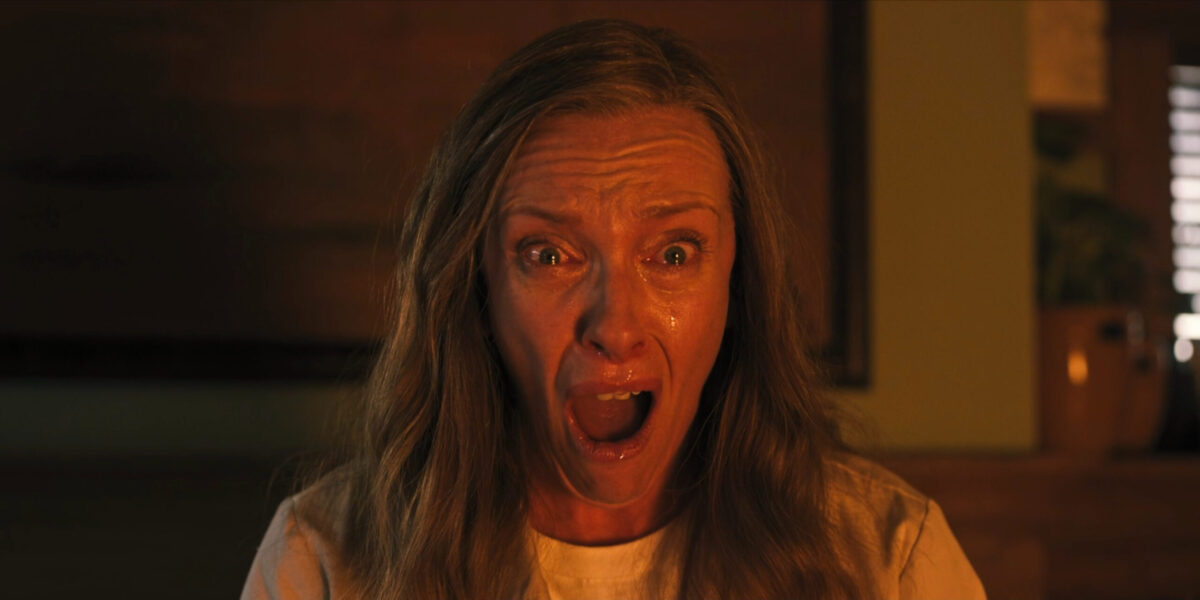
The word you wanted is “noggin”, not “nogging”. Might want to run a spell check on your work too, as there are other easily-corrected mistakes.
You don’t think I meant “rough brick masonry used to fill in the open spaces of a wooden frame”?
The sad/frustrating thing is that I do run spell check lol. Every time. Just that Google docs sometimes hangs me out to dry. Like with “nogging” or “poresession”. Why it didn’t notice those, I’m not sure. Why I didn’t? Because after writing 5k words on a movie, my brain is fried lol.
So I appreciate the assistance